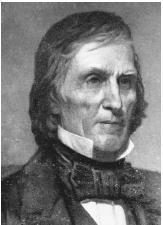Josiah Willard Gibbs
AMERICAN MATHEMATICIAN AND PHYSICIST
1839–1903
Josiah Willard Gibbs was born in New Haven, Connecticut, on February 11, 1839, into a family of academics whose connection to higher education dates back to the 1600s. Gibbs entered Yale University (where his father served as librarian) in 1854, graduated in 1858 with distinction in mathematics and Latin, and continued his studies there, in 1863 earning the first Ph.D. in engineering in the United States. He was appointed tutor and taught Latin and natural philosophy until 1866, whereupon he left New Haven to study in Europe. He attended lectures by the eminent scientists of Paris, Berlin, and Heidelberg, returning home in 1869. He was appointed professor of mathematical physics at Yale in 1871, a post he held until his death in 1903.
In 1873 Gibbs published the first two of his revolutionary papers, which unveiled graphical methods for visualizing properties such as stability, equilibrium, and critical states for thermodynamic systems. One of his major accomplishments was showing the usefulness of the "entropy" quantity that the German mathematical physicist Rudolf Clausius had posited in 1865. This was followed in 1876 by his famous "On the Equilibrium of Heterogeneous Substances" paper, in which he introduced the field of chemical thermodynamics, advancing the concept of chemical potential. Gibbs's free energy G determines whether it is favorable that chemicals will react. Gibbs employed a completely general treatment, making almost no assumptions about the properties of the interacting substances. His celebrated phase rule allowed for the identification of the number of coexisting phases in a system.

When one aspect of Gibbs's work in thermodynamics, the phase rule, is considered, just how important the discovery of this theoretical system was becomes clear. The phase rule allows one to determine the number of coexisting phases of any system, no matter how complicated. The rule relates the number of independently changeable intensive variables, or degrees of freedom, F, the number of components (i.e., substances) C, and the number of phases in equilibrium P, as follows:
F = C − P + 2
Thus, in a one-component system (such as pure water), at temperature and pressures where one phase is present ( F = 1 − 1 + 2 = 2), those variables can be varied independently (carving out an area of coexistence on a phase diagram). In order to keep two phases in coexistence ( F = 1 − 2 + 2 = 1), like water and ice, varying the pressure necessitates a specific change in the temperature (which forms a coexistence line on a phase diagram). Where all three phases (ice, water, and vapor) coexist, there are no degrees of freedom, which translates to a single point, the triple point, on a phase diagram. In other words, there is only one temperature and pressure where all three phases of water are in equilibrium. More complicated systems have more intricate phase diagrams, but the phase rule allows one to, relatively, easily determine the phase properties of any system.
Due in part to his mathematically demanding and abstract style of writing, and also since his papers were published in the obscure Transactions of the Connecticut Academy of Arts and Sciences, Gibbs's work was not immediately embraced by the scientific community, with the notable exception of the Scottish physicist James Clerk Maxwell. Consequently, many of Gibbs's results were not discovered until years or decades later by scientists ignorant of his work.
Gibbs also wrote an influential book on statistical mechanics, which developed a molecular theory of thermodynamic properties from first principles, with a treatment that was general enough to accommodate quantum mechanics , a theory that had not even been imagined yet. He championed the now standard use of vector notation over William Rowan Hamilton's quaternion algebra and wrote several seminal papers on electromagnetism in the 1880s that supported Maxwell's theory.
SEE ALSO Equilibrium ; Maxwell, James Clerk ; Thermodynamics .
Michael J. Fosmire
Bibliography
Hastings, Charles S. (1909). "Josiah Willard Gibbs." Biographical Memoirs of the National Academy of Sciences 6:372–393.
Seeger, Raymond J. (1974). J. Willard Gibbs. New York: Pergamon.